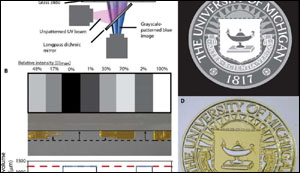Rapid and continuous 3-D printing with light
23. 1. 2019 | Phys.org | www.phys.org
Three-dimensional (3-D) printing, also known as additive manufacturing (AM), can transform a material layer by layer to build an object of interest. 3-D printing is not a new concept, since stereolithography printers have existed since the 1980s. The widespread availability and cost-effectiveness of the technology has allowed a variety of modern applications in biomedical engineering.
The contemporary process of layer-wise additive manufacture is nevertheless slow and impacts the rate of object fabrication for objects with ridged surfaces. The materials scientists developed a method using two sources of light; one to solidify the resin and another ultraviolet light to prevent resin curing on the device window during object fabrication.

In the study, scientists developed an AM system that could print continuously, at relatively high linear velocities to form 3-D structures in a single exposure. The experimental setup included a build head drawn upward from a photopolymerizable resin and two illumination sources with optics operating at different wavelengths (365 nm and 458 nm). In the experimental setup, patterned illumination passed through a transparent glass window from below and initiated resin polymerization.
Read more at Phys.org
Image Credit: Science Advances
-jk-




